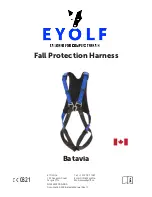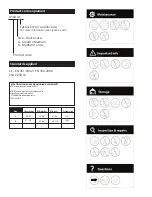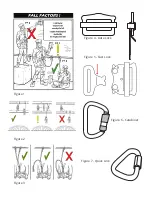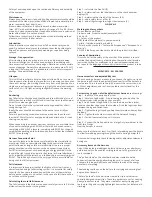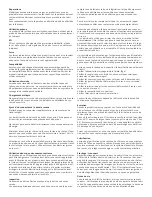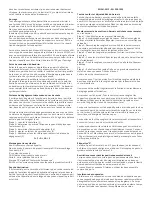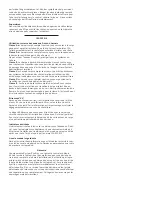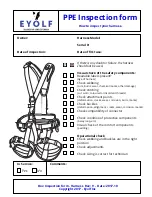
“A” Labels
The letter A for the Dorsal and A or A/2 for the Sternal D-ring(s) are to
point out that the D-ring is suitable for a fall arrest system as per CE
standard.
Work Positioning restrictions
When using the belt for work positioning, it is important that the an-
chor point is maintained at or above waist level, lanyards are kept taut,
and free movement is restricted to a maximum of 0.6 m.
If using the D-rings on the side, use both together as a pair.
Suspension intolerance
Suspension intolerance is a condition in which a person is suspend-
ed in a harness can experience certain unpleasant symptoms when
suspended for too long. The body is not tolerant of being in an upright
position and motionless at the same time. This can result in nausea,
breathlessness, disrupted vision, numbness, and other symptoms that
could lead to serious injury. Moving both legs periodically while sus-
pended upright works to circulate blood back to the heart and reduce
risk. If unconscious, rescue needs to happen immediately.
Supervision
Under certain circumstances where a person is temporarily using a
PPE against falling a competent and/or trained person could supervise
the user.
CSA Z259.10
Correct use of D-rings on a harness
Class A
full body harnesses are designed to support the body during
and after the arrest of a fall. Following CSA standards, the dorsal
attachment is the only allowed way for arresting a fall.
Class D
full body harnesses are designed for suspension or controlled
descent from a height.
Do not use the ventral (main) D-ring for fall arrest systems.
Class E
full body harnesses are designed to support a worker in a posi-
tion that reduces the worker’s profile during passage through a limited
access area. Hoisting of the worker is ussually involved.
Class L
full body harnesses are designed for use with fall restrict sys-
tems involving the use of a fall arrester that travels on a vertical lifeline
or rail mounted on a ladder.
Class P
full body harnesses are designed to position the worker during
a work operation.
Class R
full body harnesses are designed to provide protection for
workers who could be exposed to thermal hazards or momentary
electric arc of flame. In addition to the connector required for Class A,
Class R may be included with any other class configurations.
“Xh” Stretch
After a fall has occurred, it is important to know that the “Xh” stretch of
the harness is less then 30cm, depending how the harness was adjust-
ed. This information is important to calculate the free-fall clearance.
Evacuation device designed to be used with the full body harness
should be clipped into the sternal (chest) D-ring. In order to do this
right the harness should be thight around the body and close atten-
tion should be paid to the
Fall arrest indicator
The fall-arrest indicator is included on this harness below the dorsal
D-ring. The indicator(s) will deploy at a maximum rate of 4 kN and are
installed to indicate that the harness is no longer to be used after a
fall. As is required by the CSA Z259.10 standard.
Read the manual and keep it
Keep the user instructions/information accessible as a permanent
record on- and off-site. Keep a copy of the manual with the product at
all times.
Warranty
Equipment offered by Eyolf Inc. are warranted against factory defects
in workmanship and materials for a period of three years from date
of installation or use by the owner, provided that this period shall not
exceed three years from the date of manufacturing (see label on prod-
uct). Upon notice in writing, Eyolf Inc. will promptly repair or replace all
defective items. Eyolf Inc. reserves the right to elect to have any defec-
tive item returned to its plant for inspection before making a repair or
replacement. This warranty does not cover equipment
damages resulting from abuse, damage in transit, or other damage be-
yond the control of Eyolf Inc. This warranty applies only to the original
purchaser and is only one of applicable to Eyolf products, and is lieu of
all other warranties, expressed or implied.
Équipement de protection individuelle contre les chutes d’une hau-
teur.
Exigences générales relatives aux instructions d’utilisation, d’entretien,
d’examen périodique, de réparation, de marquage et d’emballage
selon EN 365:2004
Nous vous remercions d’utiliser un produit Eyolf. Nous faisons tout
notre possible pour nous assurer que les informations fournies dans
ce manuel sont exactes lors de la publication. Toutefois, nous ne ga-
rantissons pas que ces informations resteront à jour, car de nombreux
produits et techniques changent au fil du temps.
Alpinisme, escalade, spéléologie, travail en hauteur et autres activités
connexes sont intrinsèquement dangereuse en raison de facteurs
extérieurs et de risques cachés. Ne pas comprendre ni prendre des
précautions et éliminer ces risques peut entraîner des blessures
graves et la mort.
En cas de doute, n’utilisez pas le produit!
Contactez-nous si vous avez des questions ou des soucis.
Ce harnais doit être utilisé uniquement pour la protection antichute,
qui comprend l’antichute et la retenue de voyage. Si une ceinture est
présente, elle peut également être utilisée pour le positionnement de
travail lorsque les deux anneaux en D latéraux sont utilisés.
Avertissement
Condition médicale
Il faut bien comprendre que travailler en hauteur et l’utilisation de
l’équipement pour ce faire implique une certaine quantité d’effort
physique et mental. Certaines conditions médicales sont une con-
tre-indication définitive à un usage sans risque de l’équipement et du
travail en hauteur.
Formation
Une formation et une évaluation de compétences sont indispensables
avant l’utilisation de ce produit.
Les utilisateurs doivent être conscients des limitations, des précau-
tions à prendre et des dangers d’une mauvaise utilisation.
Évaluation des risques - plan de sauvetage
Une évaluation de risque et un rapide plan de sauvetage devraient
être établis au préalable avant toute activité effectuée en hauteur.
Par exemple, si l’évaluation de risque effectuée avant le début du
travail montre que le chargement dans le cas d’une utilisation par-des-
sus un rebord est possible, des précautions appropriées doivent être
prises.
Il en va de même pour faire face à toute urgence pouvant survenir
pendant le travail/l’activité. Dépendre de l’équipe locale de secours
n’est pas un plan de sauvetage et pourrait vous causer de graves en-
nuis, car il se pourrait qu’ils prennent trop de temps ou ne soient pas
en mesure d’effectuer un sauvetage.
Ayez à votre disposition un plan de sauvetage convenable!
FR

